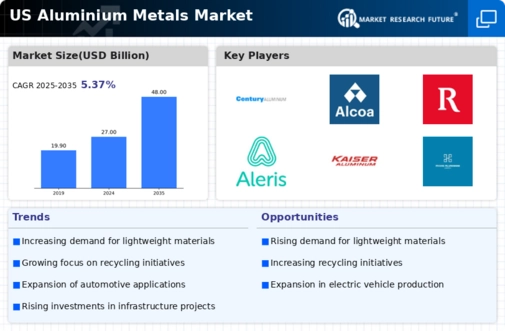The aluminium metals market in the US is characterized by a competitive landscape that is increasingly shaped by innovation, sustainability initiatives, and strategic partnerships. Key players such as Alcoa Corporation (US), Novelis Inc. (US), and Kaiser Aluminum Corporation (US) are actively pursuing strategies that emphasize technological advancements and operational efficiencies. Alcoa Corporation (US) has focused on enhancing its production capabilities through investments in low-carbon technologies, which aligns with the growing demand for sustainable aluminium solutions. Meanwhile, Novelis Inc. (US) has been expanding its recycling operations, reflecting a commitment to circular economy principles, which is becoming a critical differentiator in the market. Kaiser Aluminum Corporation (US) appears to be leveraging strategic acquisitions to bolster its product offerings and market reach, thereby intensifying competition among these major players.
The business tactics employed by these companies include localizing manufacturing and optimizing supply chains to enhance responsiveness to market demands. The market structure is moderately fragmented, with several players vying for market share, yet the influence of larger corporations remains pronounced. This competitive dynamic fosters an environment where innovation and operational excellence are paramount, as companies strive to differentiate themselves in a crowded marketplace.
In November 2025, Alcoa Corporation (US) announced a partnership with a leading technology firm to develop advanced aluminium alloys aimed at the aerospace sector. This strategic move is likely to enhance Alcoa's product portfolio and position it as a leader in high-performance materials, catering to the increasing demands of the aerospace industry for lightweight and durable components. Such collaborations may also facilitate knowledge transfer and innovation, further solidifying Alcoa's competitive edge.
In October 2025, Novelis Inc. (US) unveiled a new recycling facility in the Midwest, which is expected to increase its recycling capacity by 30%. This expansion not only underscores Novelis's commitment to sustainability but also enhances its ability to meet the rising demand for recycled aluminium, which is increasingly favored by consumers and manufacturers alike. The facility's operational efficiency could lead to cost savings and improved margins, thereby strengthening Novelis's market position.
In September 2025, Kaiser Aluminum Corporation (US) completed the acquisition of a regional aluminium fabricator, which is anticipated to enhance its production capabilities and broaden its customer base. This acquisition reflects Kaiser’s strategy to consolidate its market presence and diversify its product offerings, potentially leading to increased competitiveness in the aluminium sector. The integration of the new operations may also yield synergies that improve overall efficiency and profitability.
As of December 2025, the competitive trends in the aluminium metals market are increasingly defined by digitalization, sustainability, and the integration of artificial intelligence (AI) into production processes. Strategic alliances are becoming more prevalent, as companies recognize the value of collaboration in driving innovation and enhancing supply chain resilience. Looking ahead, the competitive differentiation in this market is likely to evolve from traditional price-based competition to a focus on technological advancements, sustainability initiatives, and reliable supply chains. This shift may redefine how companies position themselves in the market, emphasizing the importance of innovation and operational excellence.





















Leave a Comment